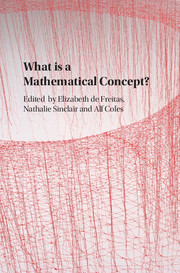Introduction
Published online by Cambridge University Press: 26 July 2017
Information
- Type
- Chapter
- Information
- What is a Mathematical Concept? , pp. 1 - 16Publisher: Cambridge University PressPrint publication year: 2017
References
Accessibility standard: Unknown
Why this information is here
This section outlines the accessibility features of this content - including support for screen readers, full keyboard navigation and high-contrast display options. This may not be relevant for you.Accessibility Information
- 1
- Cited by
